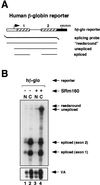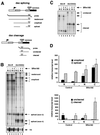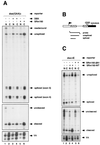SRm160 splicing coactivator promotes transcript 3'-end cleavage
- PMID: 11739730
- PMCID: PMC134228
- DOI: 10.1128/MCB.22.1.148-160.2002
SRm160 splicing coactivator promotes transcript 3'-end cleavage
Abstract
Individual steps in the processing of pre-mRNA, including 5'-end cap formation, splicing, and 3'-end processing (cleavage and polyadenylation) are highly integrated and can influence one another. In addition, prior splicing can influence downstream steps in gene expression, including export of mRNA from the nucleus. However, the factors and mechanisms coordinating these steps in the maturation of pre-mRNA transcripts are not well understood. In the present study we demonstrate that SRm160 (for serine/arginine repeat-related nuclear matrix protein of 160 kDa), a coactivator of constitutive and exon enhancer-dependent splicing, participates in 3'-end formation. Increased levels of SRm160 promoted the 3'-end cleavage of transcripts both in vivo and in vitro. Remarkably, at high levels in vivo SRm160 activated the 3'-end cleavage and cytoplasmic accumulation of unspliced pre-mRNAs, thereby uncoupling the requirement for splicing to promote the 3'-end formation and nuclear release of these transcripts. Consistent with a role in 3'-end formation coupled to splicing, SRm160 was found to associate specifically with the cleavage polyadenylation specificity factor and to stimulate the 3'-end cleavage of splicing-active pre-mRNAs more efficiently than that of splicing-inactive pre-mRNAs in vitro. The results provide evidence for a role for SRm160 in mRNA 3'-end formation and suggest that the level of this splicing coactivator is important for the proper coordination of pre-mRNA processing events.
Figures






Similar articles
-
An evolutionarily conserved role for SRm160 in 3'-end processing that functions independently of exon junction complex formation.J Biol Chem. 2003 Nov 7;278(45):44153-60. doi: 10.1074/jbc.M306856200. Epub 2003 Aug 27. J Biol Chem. 2003. PMID: 12944400
-
The SRm160/300 splicing coactivator is required for exon-enhancer function.Proc Natl Acad Sci U S A. 1999 May 25;96(11):6125-30. doi: 10.1073/pnas.96.11.6125. Proc Natl Acad Sci U S A. 1999. PMID: 10339552 Free PMC article.
-
The SRm160/300 splicing coactivator subunits.RNA. 2000 Jan;6(1):111-20. doi: 10.1017/s1355838200991982. RNA. 2000. PMID: 10668804 Free PMC article.
-
A conserved mRNA export machinery coupled to pre-mRNA splicing.Cell. 2002 Feb 22;108(4):523-31. doi: 10.1016/s0092-8674(02)00627-x. Cell. 2002. PMID: 11909523 Review.
-
Nuclear mRNA binding proteins couple pre-mRNA splicing and post-splicing events.Mol Cells. 2001 Aug 31;12(1):1-10. Mol Cells. 2001. PMID: 11561715 Review.
Cited by
-
Distance-dependent processing of adeno-associated virus type 5 RNA is controlled by 5' exon definition.J Virol. 2007 Aug;81(15):7974-84. doi: 10.1128/JVI.00714-07. Epub 2007 May 16. J Virol. 2007. PMID: 17507471 Free PMC article.
-
Molecular anatomy of a speckle.Anat Rec A Discov Mol Cell Evol Biol. 2006 Jul;288(7):664-75. doi: 10.1002/ar.a.20336. Anat Rec A Discov Mol Cell Evol Biol. 2006. PMID: 16761280 Free PMC article.
-
Regulation of mRNA export by the PI3 kinase/AKT signal transduction pathway.Mol Biol Cell. 2013 Apr;24(8):1208-21. doi: 10.1091/mbc.E12-06-0450. Epub 2013 Feb 20. Mol Biol Cell. 2013. PMID: 23427269 Free PMC article.
-
The spatial targeting and nuclear matrix binding domains of SRm160.Proc Natl Acad Sci U S A. 2003 Mar 18;100(6):3269-74. doi: 10.1073/pnas.0438055100. Epub 2003 Mar 6. Proc Natl Acad Sci U S A. 2003. PMID: 12624182 Free PMC article.
-
Serine/arginine-rich proteins contribute to negative regulator of splicing element-stimulated polyadenylation in rous sarcoma virus.J Virol. 2007 Oct;81(20):11208-17. doi: 10.1128/JVI.00919-07. Epub 2007 Aug 1. J Virol. 2007. PMID: 17670832 Free PMC article.
References
-
- Birse, C. E., L. Minvielle-Sebastia, B. A. Lee, W. Keller, and N. J. Proudfoot. 1998. Coupling termination of transcription to messenger RNA maturation in yeast. Science 280:298–301. - PubMed
-
- Blencowe, B. J., A. L. Bowman, S. McCracken, and E. Rosonina. 1999. SR-related proteins and the processing of messenger RNA precursors. Biochem. Cell Biol. 77:277–291. - PubMed
Publication types
MeSH terms
Substances
LinkOut - more resources
Full Text Sources
Other Literature Sources
Molecular Biology Databases
Miscellaneous
